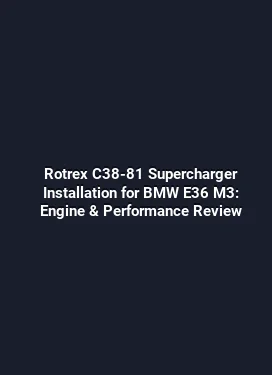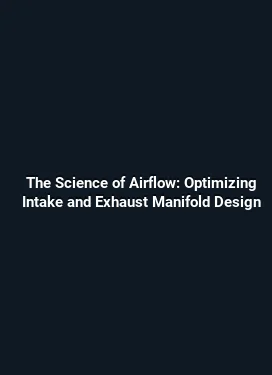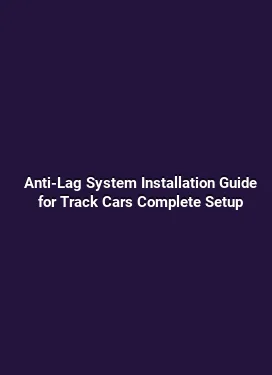VVT vs. VVL: How Variable Valve Timing Affects Engine Power and Efficiency
Understanding the Core Concepts: What VVT and VVL Do in the Engine

Modern internal combustion engines rely on precise control of when the intake and exhaust valves open and close, as well as how much they lift. Two widely used technologies in this realm are Variable Valve Timing (VVT) and Variable Valve Lift (VVL). VVT focuses on adjusting the timing of valve events, typically the opening and closing points of the camshaft relative to the crankshaft. By advancing or retarding these events, the engine can optimize combustion across a broad range of speeds and loads. VVL, on the other hand, governs the physical distance a valve travels to reach its maximum lift. This directly affects the amount of air that can enter or exit the cylinder during each cycle and can be used to tailor airflow for different operating conditions.
In practice, many modern engines combine both technologies to create a flexible breathing system. The result is improved throttle response at low rpm, better high-rpm power, and, in some cases, enhanced fuel economy. The most common realization of VVT in production engines is a continuously variable system that can shift the valve events by degrees of crankshaft rotation. VVL configurations often use cam profiles or secondary lobe profiles that alter lift as conditions change, sometimes in conjunction with variable camshaft phasing.
How Variable Valve Timing Impacts Power Across the RPM Range
At low to mid RPM, the engine benefits from retimed valve events that reduce pumping losses and improve low-end torque. By delaying exhaust valve closure or advancing intake valve opening, the engine can recover energy that would otherwise be lost to friction and residual gases. The result is quicker throttle response and a steadier torque curve, which translates to a more usable power band in everyday driving scenarios.
As RPM increases, the timing can be shifted to optimize the air charge and the combustion process. Advancing intake timing at higher speeds can improve cylinder fill, allowing more air and fuel to enter during the intake stroke. This can boost peak power and improve the engine’s ability to sustain higher revs. However, the exact benefits depend on the engine’s displacement, geometry, and fueling strategy. In some designs, a misbalanced or poorly tuned cam phasing strategy can lead to a drop in efficiency or a narrow optimal operating window, underscoring the importance of integration with the engine’s control software and hardware constraints.
Practical implications for daily driving

Drivers may notice smoother acceleration and more linear power delivery when VVT is actively optimizing valve timing. This translates to fewer abrupt changes in throttle response and a feeling of readiness at mid-range speeds. In performance-oriented applications, VVT helps keep the engine within an optimal window where the air-fuel mixture is most effective, enabling sustained acceleration without the need for frequent downshifts.
Meanwhile, VVL contributes to improved mid-range torque by adjusting how much air and exhaust gas can flow at a given lift. This can reduce throttle bottlenecks and make the engine feel more responsive, especially in urban driving where frequent gear changes and stop-and-go conditions prevail.
Variable Valve Lift: Why Lift Matters and How It Interacts with Timing
Variable Valve Lift systems modulate the degree to which valves lift during the intake and exhaust events. A higher lift typically allows more air to enter and more exhaust to exit, increasing the potential for power at higher engine speeds. Conversely, a lower lift can reduce pumping losses and improve idle stability and low-end torque. The combination of lift and timing control enables a broader operating envelope than timing control alone.
There are several mechanical implementations of VVL, including camshaft phasers that adjust the relative position of cam lobes, discrete lift mechanisms that switch between different lobe profiles, and hydraulic or electric actuators that vary lift on the fly. In many engines, lift adaptation is used to reduce fuel consumption during light-load operation while preserving high-rpm capability when demanded by the driver. This dual capability helps address the classic trade-off between efficiency and performance.
Real-world benefits and trade-offs
From a performance perspective, increasing lift during high-load situations can significantly raise the volumetric efficiency of the engine. This means more air is available for combustion, leading to higher peak power and a stronger torque curve at the top end. The downside can be greater mechanical complexity, potential maintenance considerations, and sensitivity to oil quality and temperature, since many lift mechanisms rely on precise hydraulic or electronic control.
In everyday driving, optimized lift during mid-range operation reduces pumping losses when the throttle is partially opened. This translates to improved fuel economy without sacrificing power when a burst of acceleration is required. The key to maximizing benefits is robust control strategies and reliable actuation hardware that can respond quickly to changing engine loads and speeds.
Engine Control Integration: How the ECM/MEC Manages VVT and VVL
The effectiveness of timing and lift modulation hinges on the engine’s control system. Modern ECUs (engine control units) gather data from a network of sensors, including crank position, cam position, manifold pressure, throttle position, air mass, and engine temperature. This data feeds sophisticated algorithms that decide when to alter valve timing and lift in real time. The objective is to maintain optimal combustion phasing, maximize efficiency, and deliver power when required by the driver’s input.
Engine maps or calibration strategies play a crucial role. A well-tuned calibration will account for fuel quality, altitude, ambient temperature, and even the vehicle’s drivetrain configuration. In performance applications, calibration may emphasize high-rpm performance, whereas in fuel-efficient designs, the control strategy may prefer smoothness and economy in cruise conditions. Regular software updates can sometimes improve efficiency and drivability by refining these maps and improving sensor fusion algorithms.
Diagnostics and longevity considerations
Because VVT and VVL systems rely on precision actuation and hydraulic or electric control, they are susceptible to wear and contamination. Routine oil changes with the correct specification play a pivotal role, as oil quality directly affects hydraulic phasers and lift actuators. Contaminants in the oil can impede the smooth movement of cam phasers or lift actuators, leading to delayed timing changes or inconsistent lift. When diagnosing drivability issues, technicians will often inspect oil pressure, actuator responsiveness, and sensor readings to determine whether the issue arises from mechanical wear, control software, or fuel delivery problems.
Maintenance considerations also include ensuring the timing chain or belt tension is correct, as any slack or misalignment can undermine phasing accuracy. Some vehicles use a variable oil pressure system that can be sensitive to oil temperature; in those cases, cold starts may reveal different behavior until the oil warms up to operating temperature.
Practical Scenarios: When VVT and VVL Make a Difference
Urban commuting with frequent stop-and-go traffic benefits from smoother throttle response and improved low-end torque, both of which can be enhanced by well-calibrated timing and lift strategies. In highway cruising, optimized timing helps minimize pumping losses and sustain efficiency at steady speeds. On a ramp or overtaking maneuver, the benefit becomes tangible as the engine must deliver power without excessive throttle pedal travel.
In performance-oriented driving, such as track days or spirited driving, a well-tuned VVT/VVL combination allows the engine to reach higher RPMs with controlled valve events and lift, enabling the engine to breathe efficiently even at redline. This broadens the usable torque band and reduces the need for frequent gear changes, contributing to a more engaging driving experience.
Choosing the right setup for your vehicle
For owners evaluating a new car, the presence of advanced valve control systems can be a differentiator in drivability. Vehicles designed with a focus on smooth urban performance typically emphasize low-end torque and refined throttle response facilitated by VVT and moderate lift strategies. Sports-oriented models, conversely, may adopt aggressive lift profiles and quicker phasing shifts to maximize power at high revs. When evaluating a vehicle, consider how the system behaves across different driving scenarios: idle, mid-range acceleration, highway cruise, and high-load overtaking. A test drive can reveal how quickly timing and lift adjust to rapidly changing conditions and whether the transitions feel linear or abrupt.
Common Misconceptions and How to Address Them
One frequent misconception is that VVT automatically yields better fuel economy in all conditions. The reality is context-dependent: while optimal timing can reduce pumping losses and improve efficiency under many operating modes, there are scenarios where the benefits are modest or offset by higher mechanical complexity and calibration demands. Another misconception is that higher lift always means more power. In truth, the benefit of lift is highly dependent on timing, intake tract design, and combustion characteristics. Too much lift at inopportune times can lead to valve float, valve train wear, or inefficient flow patterns that degrade performance instead of enhancing it.
Finally, some assume that VVT and VVL require extensive maintenance. While these systems do require proper lubrication and clean fuel quality, many modern designs are designed for long service intervals. Adhering to manufacturer-recommended maintenance schedules and using OEM-recommended fluids helps ensure longevity and predictable behavior.
How to optimize your vehicle’s valve control system in a practical way
Practical steps include keeping the engine oil at the correct level and using high-quality oil that meets the manufacturer’s specifications. Regular inspections of the valve train, phasers, and lift actuators during routine maintenance can catch wear early. If a vehicle exhibits inconsistent idle, reduced power at high rpm, or unusual engine noises, a diagnostic check focusing on valve timing sensors, phasers, and lift mechanisms can identify potential issues before they become serious.
Beyond maintenance, selecting tires and gearing that suit the engine’s torque characteristics can help you feel the benefits of valve control in everyday driving. A drivetrain setup that matches the engine’s power band ensures that the delivered torque is effectively transferred to the wheels without excessive throttle input or gear hunting.
Bottom-Line Perspectives: Engineering, Efficiency, and Driving Experience
The interplay between timing and lift defines how an engine breathes. Variable Valve Timing shifts the spark of timing to optimize combustion, while Variable Valve Lift adjusts the amount of air and exhaust flow through the cylinders. Together, they broaden the operating envelope, delivering stronger performance when demanded and greater efficiency when cruising. The practical impact is a more responsive, adaptable engine that can maintain power without sacrificing economy in everyday use. Real-world benefits hinge on meticulous integration across mechanical components, calibration strategies, and the vehicle’s overall design, from intake manifolds to exhaust routing and ECU software.
In summary, VVT and VVL are complementary technologies that, when thoughtfully engineered and properly maintained, offer tangible improvements in drivability, efficiency, and performance. Understanding how they interact helps enthusiasts and everyday drivers alike appreciate the sophistication behind modern engines and what to look for when evaluating a vehicle’s powertrain characteristics.






